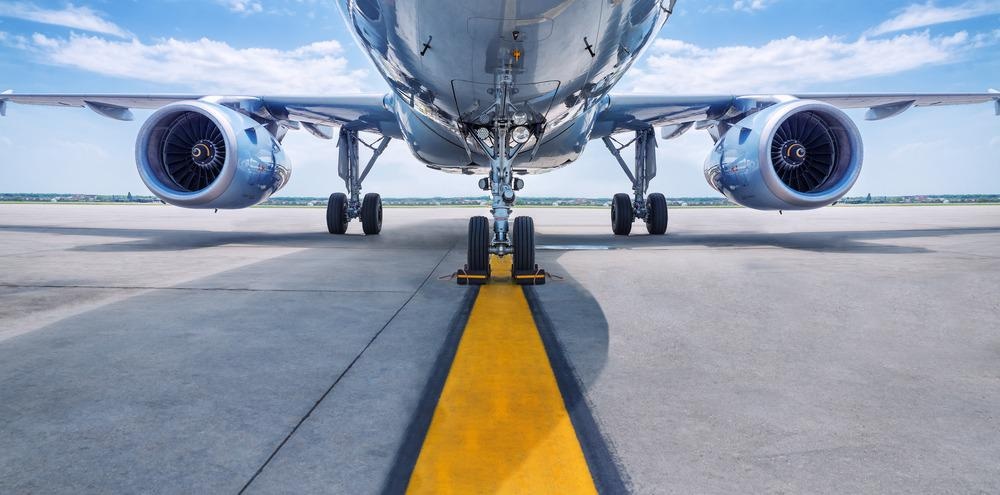
Image Credit: frank_peters/Shutterstock.com
Surface metrology, which is used to assess the topography of surfaces, has demonstrated its value in evaluating surface runway textures. Recent research by an international team of scientists from institutions in China, Sweden, and Belgium, has illustrated how surface metrology techniques can be applied to assess how runways change due to cyclic loading and environmental factors. Establishing a reliable method to collect and analyze this type of data opens the door to a process of improving runway materials and supporting more predictable and safer aircraft landings.
A Need to Improve Safety on the Runway
Aircraft landing is very much determined by the friction force generated by the texture of runway surfaces. Deterioration of such surfaces and environmental factors such as surface water can influence this friction force.
Over the past few years, there have been several reported incidences where planes have overrun the runway during landing, causing damage to the aircraft and putting passengers' and workers' lives in danger. These incidences have often been related to heavy rain conditions, highlighting the impact of certain factors on the runway surface's friction force.
The aviation industry needs a reliable methodology for assessing runway surface topography to analyze runway surface conditions so that take-off and landing procedures can be improved and runway excursions can be avoided. This will, in turn, improve airport safety.
Runway Surfaces Dictate Friction Force
The runway’s surface texture produces the friction force involved in aircraft landing. Friction force is generated as energy dissipates from the plane’s wheels. However, this force changes depending on environmental conditions and runway surface wear.
Landing is known to be the most challenging part of the flight. As the aircraft approaches the runway, its movement is influenced by gravity and various aerodynamic forces and moments. Once the aircraft makes contact with the runway, a new force called the wheel friction force is introduced, which acts on the aircraft as the other forces decrease. The friction force depends on the magnitude of aerodynamic lift. As the time the plane spends moving on the runway increases, the magnitude of aerodynamic lift decreases and the friction force increases.
However, the surface texture of the runway can significantly impact the friction force. If it is not accounted for, then pilots run the risk of miscalculating their landing, for instance, not anticipating the need for extended runway lengths.
Wet and worn-out runways in particular present safety concerns in terms of the impact they have on landings. Studies have shown that friction force is significantly reduced on older, worn-out runways and that wet runways can cause traction failure.
Current methods used to analyze skid resistance are based on periodic friction measurement, which does not account for surface deterioration or environmental conditions such as rain. Therefore, there is a need for a runway surface analysis model that incorporates these factors.
The Impact of Surface Texture Deterioration and Wet Surface Conditions on Friction Force
In January 2021, researchers proposed an integrated approach to quantifying wet and dry runway skid resistance. Their approach was based on a texture wear algorithm and a hydroplaning model. The researchers obtained kinematic friction coefficients between runways and the rubber materials of wheels using rubber's viscoelastic property and the power spectral density (PSD) of pavements. Researchers then developed a finite element (FE) model relating to the actual texture surface and real interaction models. The model's accuracy was tested by comparing the hydroplaning results of the FE model with those collected experimentally.
The results showed that numerous factors impact the coefficient of friction between the runway and aircraft wheels. The team concluded that, as the aircraft landing speed increases, the runway friction coefficient decreases. They were also able to generate a hierarchy of the three types of runway tested in the study in terms of their coefficients: open-graded friction course (OGFC) > stone mastic asphalt (SMA) > asphalt concrete (AC). The data also showed that the worn-out SMA and AC specimens' friction coefficients decreased by 0.03 and 0.06 at a landing speed of 55 km/h.
The team concluded that the optimal friction coefficient decreased as the wear ratio increased. They also found that wear's influence was more significant at low landing speeds than high landing speeds. The conclusion was that the wet runway's friction coefficients, compared to the dry runway, decreased by 0.36 and 0.38 in partial hydroplaning at water film depths of 3 and 5 mm at a landing speed of 205 km/h. In contrast, at 55 km/h, the friction coefficients decreased by 0.04 and 0.08, demonstrating that hydroplaning effects are more evident at high rather than low speeds.
The new FE model established in the paper provides a method of analyzing runway skid resistance. However, more work is needed to assess different wet weather conditions other than those focused on in the current research.
References and Further Reading
Analysis of Aircraft Overruns and Undershoots for Runway Safety Areas. Airport Cooperative Research Program. Available at: https://www.icao.int/SAM/Documents/2011/AGAASEROSTUDIES/ACRP_rpt_003.pdf
Suharev, A., Shestakov, V. and Stefanski, K., 2019. Analysis of the affecting factors on aircraft take-off and landing ground path length. https://aip.scitation.org/doi/pdf/10.1063/1.5091917
Zhu, X., Yang, Y., Zhao, H., Jelagin, D., Chen, F., Gilabert, F. and Guarin, A., 2021. Effects of surface texture deterioration and wet surface conditions on asphalt runway skid resistance. Tribology International, 153, p.106589. https://www.sciencedirect.com/science/article/abs/pii/S0301679X20304199?via%3Dihub
Disclaimer: The views expressed here are those of the author expressed in their private capacity and do not necessarily represent the views of AZoM.com Limited T/A AZoNetwork the owner and operator of this website. This disclaimer forms part of the Terms and conditions of use of this website.